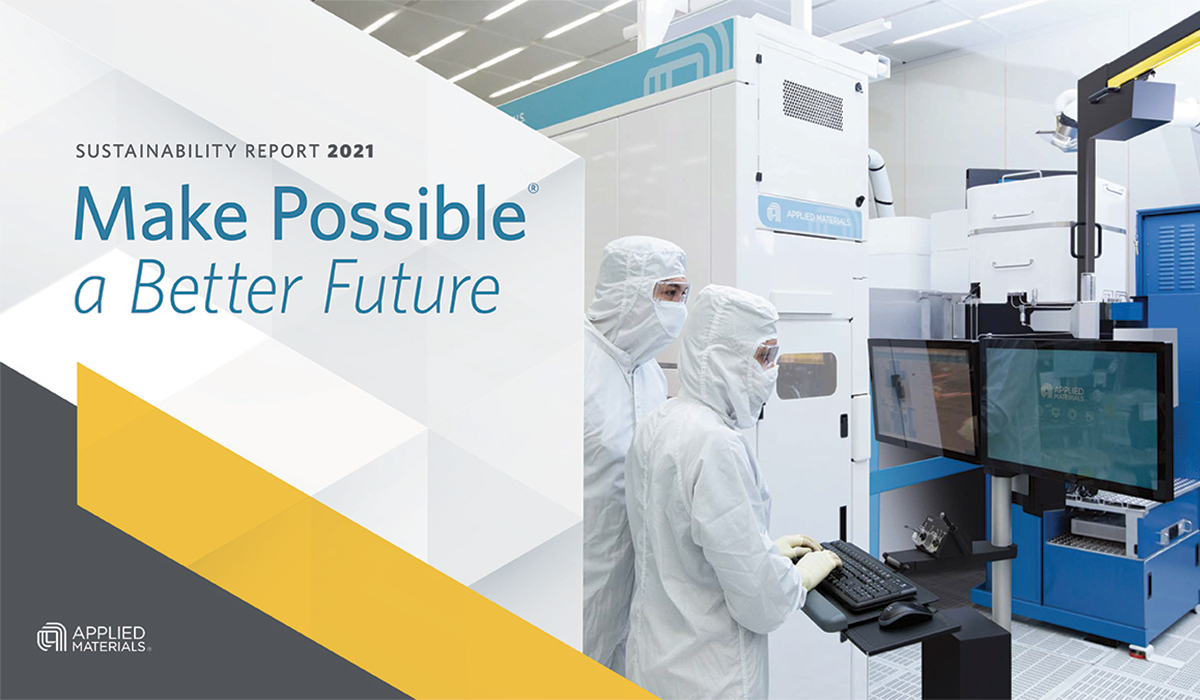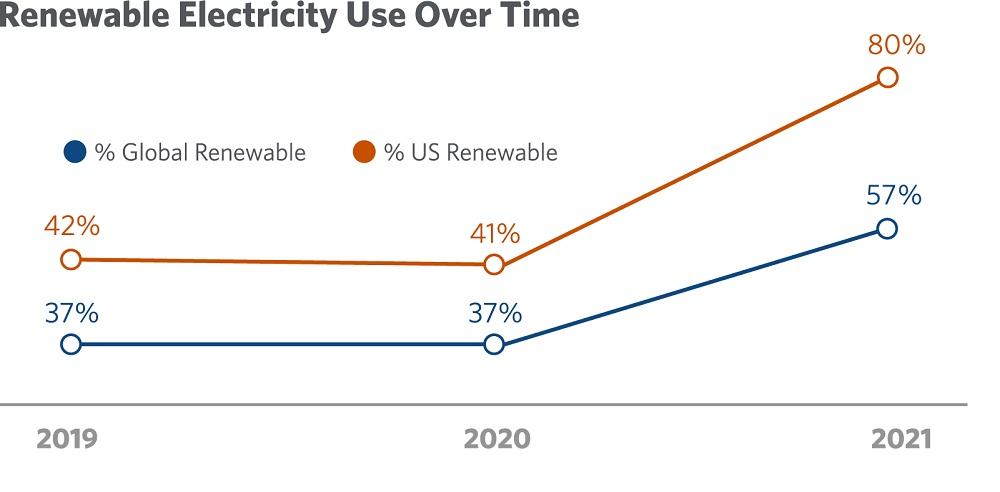Enabling a Sustainable Chip Industry Requires a Long-Term Vision and Near-Term Actions
By Chris Librie
Applied Materials has published its Sustainability Report for 2021, which we titled Make Possible® a Better Future. It highlights the significant progress we’ve made in reducing our carbon footprint and transitioning to renewable energy. At the same time, the report underscores the sustainability challenges we continue to face as a company and as an industry.
The good news: Through increased use of renewable electricity, Applied achieved a 28-percent reduction in our Scope 1 and Scope 2 emissions footprint—the emissions produced directly by Applied and by the electricity we purchase—even as our overall energy consumption rose by approximately 7 percent to support new facilities and expanded production. Key initiatives enabling the emissions reduction include previous investments in on-site solar power generation at our facilities in Singapore, Texas, India and China, as well as a virtual power purchase agreement with White Mesa Wind, LLC in White Mesa, Texas.
Today, renewable power accounts for approximately 80 percent and 57 percent, respectively, of our U.S. and global energy consumption. Continued progress is essential, both to accommodate the growth in demand for our products we anticipate over the next decade and beyond, as well as to reach our commitment to achieve 100-percent renewable energy use in the U.S. by 2022, and globally by 2030.
In terms of Scope 3 emissions—those generated across our entire value chain—Applied has focused on establishing benchmarks and priorities that can inform future action. Early in 2022, we assessed the 15 categories defined by the Greenhouse Gas Protocol to identify and inventory the primary sources of our Scope 3 emissions for our semiconductor products.
Using 2019 as a baseline, we found that Use of Sold Products (Category 11) represents the lion’s share—nearly 80 percent—of our Scope 3 emissions. This category comprises the combined total lifetime emissions from all Applied semiconductor equipment sold during a reporting year. The metric includes emissions from energy consumption in customer fabs, as well as chemicals and gases used in operational processes. Purchased Goods and Services (Category 1) represents about 15 percent of Applied’s estimated supply chain emissions and is the second largest contributor to our Scope 3 footprint for our semiconductor equipment.
Reducing Scope 3 Emissions Requires Collective Action
Reducing Scope 1 and Scope 2 emissions is a relatively straightforward task; we can refine our consumption and sourcing practices to improve the energy sustainability of our operations. Moreover, we can directly measure the impact of those initiatives against the aggressive targets we’ve set.
Reducing Scope 3 emissions represents a much more challenging proposition. Myriad complexities are involved in gauging emission causes, effects and impacts over the long term. Corrective actions require coordination and collaboration across the industry ecosystem. Towards this end, we’re working with other industry leaders to align on standards for measuring semiconductor product emissions, as well as to collectively implement initiatives to drive down emissions in line with science-based targets. To be effective, these efforts will require shared responsibility and—more importantly—specific organizational commitments to ensure accountability.
The Semiconductor Conundrum
Semiconductors play a critical role in enabling digital transformation. For one thing, they underlie technology innovations such as cloud computing, intelligent automation and robotics—innovations that allow businesses to streamline their operations and create new ways of engaging with customers. Renewable energy and smart grids rely on semiconductors, as do collaboration and remote monitoring tools that dramatically reduce the need for travel.
In other words, business and sustainability agendas will continue to drive demand for semiconductors. As the world uses more chips, it is crucial for the semiconductor industry to continue developing cleaner and more sustainable operational models, otherwise we ultimately risk becoming part of the problem rather than the solution.
In his keynote speech at SEMICON West 2020, Applied’s CEO Gary Dickerson illustrated these risks and put forth a call to action for the industry. Simply put, it is imperative to enable a smart, digital future while simultaneously reducing our environmental impact. Toward this goal, Applied created an environmental, social and governance (ESG) framework bringing together thought leaders across our business and industry.
Long-Term Vision, Near-Term Actions
To address the sustainability challenge, we need to work individually as organizations and collectively as an industry to define goals and agree on actions. To tackle this transformational task, it’s instructive to consider lessons learned from businesses pursuing any type of strategic initiative that involves dramatic change and fundamentally new ways of doing things.
Experience has shown that businesses pursuing transformation often make the mistake of setting overly ambitious goals without developing a clear-cut plan on how to achieve them. Conversely, many dive in with a hodgepodge of discrete, tactical initiatives that yield limited benefits.
Successful initiatives combine a long-term strategic vision together with near-term actions that deliver measurable results. Put differently, high-level discussions around the potential future state are tied to a detailed roadmap that defines specific actions and how they contribute to the ultimate goal.
A similar mindset can help us continue our progress towards building a sustainable company (as measured by reduced Scope 1 and Scope 2 emissions) and enabling a sustainable industry by contributing to the development and execution of ecosystem-wide Scope 3 reduction strategies. Applied’s commitment to supporting this comprehensive approach will include refining our data, analytical models and assumptions around Scope 3 emissions, as well as establishing science-based targets to ensure that our goals align with continually evolving findings. At the same time, we will focus on achieving specific targets, such as keeping emissions in line with the 1.5°C pathway that has been agreed to as an international standard. Most importantly, we’ll seek to develop and enhance industry partnerships to ensure collective and collaborative action towards our shared goals.
Chris Librie
Director of ESG, Corporate Sustainability and Reporting
Chris Librie is director of ESG, corporate sustainability and reporting. Prior to joining Applied Materials in 2020, Chris led ESG and corporate sustainability programs at Samsung Semiconductor, eBay and HP Inc. He holds an MBA from the University of Edinburgh and an undergraduate degree in history from the University of Pennsylvania.



